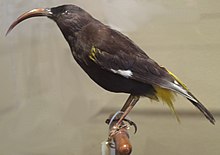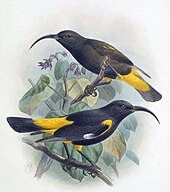
The ʻiʻiwi or scarlet honeycreeper is a species of Hawaiian honeycreeper. The ʻiʻiwi is a highly recognizable symbol of Hawaiʻi. The ʻiʻiwi is one of the most common endemic birds of the Hawaiian Islands.
Located about 2300 miles (3680 km) from the nearest continental shore, the Hawaiian Islands are the most isolated group of islands on the planet. The plant and animal life of the Hawaiian archipelago is the result of early, very infrequent colonizations of arriving species and the slow evolution of those species—in isolation from the rest of the world's flora and fauna—over a period of at least 5 million years. As a consequence, Hawai'i is home to a large number of endemic species. The radiation of species described by Charles Darwin in the Galapagos Islands which was critical to the formulation of his theory of evolution is far exceeded in the more isolated Hawaiian Islands.

The Kauaʻi ʻōʻō or ʻōʻōʻāʻā was the last member of the ʻōʻō (Moho) genus within the Mohoidae family of birds from the islands of Hawaiʻi. The entire family is now extinct. It was previously regarded as a member of the Australo-Pacific honeyeaters.
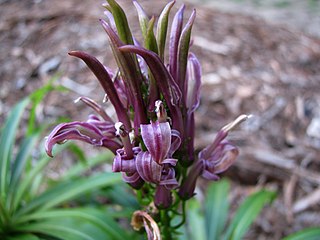
The Hawaiian lobelioids are a group of flowering plants in the bellflower family, Campanulaceae, subfamily Lobelioideae, all of which are endemic to the Hawaiian Islands. This is the largest plant radiation in the Hawaiian Islands, and indeed the largest on any island archipelago, with over 125 species. The six genera involved can be broadly separated based on growth habit: Clermontia are typically branched shrubs or small trees, up to 7 metres (23 ft) tall, with fleshy fruits; Cyanea and Delissea are typically unbranched or branching only at the base, with a cluster of relatively broad leaves at the apex and fleshy fruits; Lobelia and Trematolobelia have long thin leaves down a single, non-woody stem and capsular fruits with wind-dispersed seeds; and the peculiar Brighamia have a short, thick stem with a dense cluster of broad leaves, elongate white flowers, and capsular fruits. The relationships among the genera and sections remains unsettled as of April 2022.

The Hawaiʻi ʻōʻō is a member of the extinct genus of the ʻōʻōs (Moho) within the extinct family Mohoidae. It was previously regarded as member of the Australo-Pacific honeyeaters (Meliphagidae).

The Bishop's ‘ō‘ō or Molokai ‘ō‘ō was the penultimate member of the extinct genus of the ‘ō‘ōs (Moho) within the extinct family Mohoidae. It was previously regarded as member of the Australo-Pacific honeyeaters (Meliphagidae). Lionel Walter Rothschild named it after Charles Reed Bishop, the founder of the Bishop Museum.

Mamo or woowoo is a common name for two species of extinct birds. Together with the extant ʻIʻiwi they make up the genus Drepanis. These nectarivorous finches were endemic to Hawaii but are now extinct.

The black mamo, also known as the hoa, is an extinct species of Hawaiian honeycreeper once endemic to the island of Molokai; there is also subfossil evidence of it having lived on Maui.

The greater ʻamakihi is an extinct species of Hawaiian honeycreeper in the subfamily Carduelinae of the family Fringillidae.
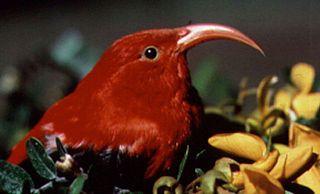
Hawaiian honeycreepers are a group of small birds endemic to Hawaiʻi. They are members of the finch family Fringillidae, closely related to the rosefinches (Carpodacus), but many species have evolved features unlike those present in any other finch. Their great morphological diversity is the result of adaptive radiation in an insular environment. Many have been driven to extinction since the first humans arrived in Hawaii, with extinctions increasing over the last two centuries following European discovery of the islands, with habitat destruction and especially invasive species being the main causes.

The ʻahu ʻula, and the mahiole were symbols of the highest rank of the chiefly aliʻi class of ancient Hawaii.
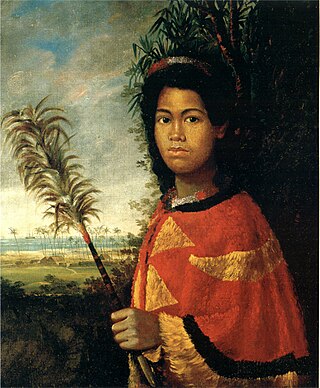
Nāhiʻenaʻena's Pāʻū is the largest known piece of Hawaiian feather work. It is a feather skirt (pāʻū) made for Princess Nāhiʻenaʻena.

Hawaiian feather helmets, known as mahiole in the Hawaiian language, were worn with feather cloaks. These were symbols of the highest rank reserved for the men of the aliʻi, the chiefly class of Hawaii. There are examples of this traditional headgear in museums around the world. At least sixteen of these helmets were collected during the voyages of Captain Cook. These helmets are made from a woven frame structure decorated with bird feathers and are examples of fine featherwork techniques. One of these helmets was included in a painting of Cook's death by Johann Zoffany.

Cyanea is a genus of flowering plants in the family Campanulaceae that are endemic to Hawaii. The name Cyanea in Hawaiian is hāhā.
Clermontia drepanomorpha is a rare species of flowering plant in the bellflower family known by the common name Kohala Mountain clermontia. It is one of several Hawaiian lobelioids in genus Clermontia that are known as `oha wai. This plant is endemic to Kohala, a volcano at the northern end of the island of Hawaii. This is a federally listed endangered species of the United States. It is a perennial tree that can be terrestrial or epiphytic and it grows in wet boggy forests.
Clermontia peleana is a rare species of flowering plant in the bellflower family known by the common name Pele clermontia. It is one of several Hawaiian lobelioids in genus Clermontia that are known as `oha wai. This plant is endemic to the island of Hawaii, where it is known from a few individuals. It is a federally listed endangered species of the United States.
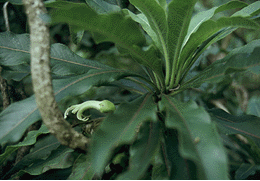
Clermontia pyrularia is a rare species of flowering plant in the bellflower family known by the common names Hamakua clermontia and pear clermontia. It is one of several Hawaiian lobelioids in genus Clermontia that are known as ʻoha wai and haha. It is endemic to the island of Hawaiʻi, where there is one remaining wild population containing 15 individuals and several propagated individuals that have been planted in protected habitat. This is a federally listed endangered species of the United States.
Cyanea procera is a rare species of flowering plant in the bellflower family known by the common name Molokai cyanea. It is endemic to Hawaii, where it is known only from the island of Molokaʻi. It is a federally listed endangered species of the United States. Like other Cyanea it is known as haha in Hawaiian.

Clermontia montis-loa, or Mauna Loa clermontia, is a species of Hawaiian lobelioid endemic to the eastern windward slopes of Mauna Loa on the island of Hawai'i. Like other Clermontia, it is referred to as ʻŌhā wai in Hawaiian.
